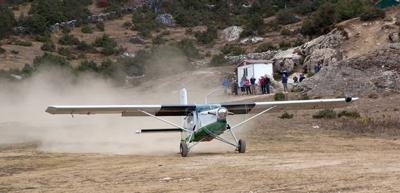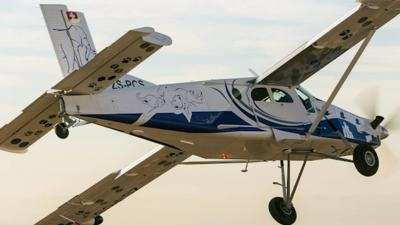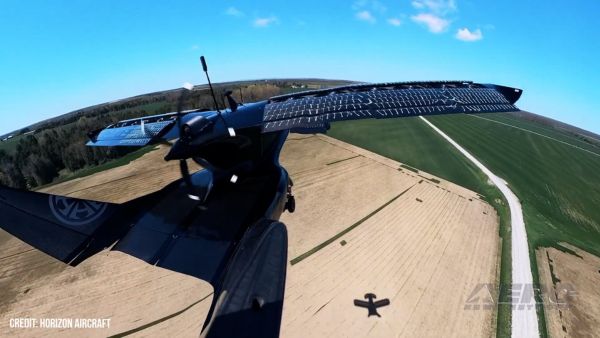Sat, Aug 08, 2020
AD 2020-16-02 Describes The Unsafe Condition As Rudder Shaft Assemblies With Incorrect Rivet Configurations
The FAA is adopting a new airworthiness directive (AD) for Pilatus Aircraft Ltd. Models PC-6, PC-6/350, PC-6/350-H1, PC-6/350-H2, PC-6/A, PC-6/A-H1, PC-6/A-H2, PC-6/B-H2, PC-6/B1-H2, PC-6/B2-H2, PC-6/B2-H4, PC-6/C-H2, PC-6/C1-H2, PC-6-H1, and PC-6-H2 airplanes.

This AD results from mandatory continuing airworthiness information (MCAI) issued by an aviation authority of another country to identify and correct an unsafe condition on an aviation product. The MCAI describes the unsafe condition as rudder shaft assemblies with incorrect rivet configurations. The FAA is issuing this AD to address the unsafe condition on these products. This AD is effective September 9, 2020.
Supplementary Information: The FAA issued a notice of proposed rulemaking (NPRM) to amend 14 CFR part 39 by adding an AD that would apply to Pilatus Aircraft Ltd. Models PC-6, PC-6/350, PC-6/350-H1, PC-6/350-H2, PC-6/A, PC-6/A-H1, PC-6/A-H2, PC-6/B-H2, PC-6/B1-H2, PC-6/B2-H2, PC-6/B2-H4, PC-6/CH2, PC-6/C1-H2, PC-6-H1, and PC-6-H2 airplanes. The NPRM was published in the Federal Register on July 5, 2019 (84 FR 32099). The NPRM proposed to correct an unsafe condition for the specified products and was based on AD No. 2018-0222, dated October 19, 2018, issued by the European Aviation Safety Agency (EASA), which is the Technical Agent for the Member States of the European Community (referred to after this as “the MCAI”).

The MCAI states:
- During a recent check flight with a PC-6, the pilot experienced loss of rudder control. The consequent precautionary landing resulted in a runway excursion and damage to the aeroplane, but without serious injuries to the occupants. The post-event inspection of the affected rudder shaft assembly found an incorrect rivet configuration. Subsequent investigation results identified that the tapered pins had been replaced with an insufficient quantity of rivets of unknown origin, which effectively constituted a modification that does not conform to any of the three different Pilatus-approved configurations. Prompted by this event, five more aeroplanes were inspected and various non-standard rivet configurations were found in the same area. It cannot be excluded that more PC-6 aeroplanes have had a similar modification applied.
- This condition, if not detected and corrected, could lead to failure or loss of rivets, possibly resulting in reduced control of the aeroplane. To address this potential unsafe condition, Pilatus Aircraft Ltd issued the [service bulletin] SB to provide inspection instructions.
- For the reasons described above, this [EASA] AD requires a one-time inspection of the affected part to determine the rivet configuration and, depending on findings, accomplishment of applicable corrective action(s). This [EASA] AD also requires inspection of affected parts held as spare, and depending on findings, corrective action(s), prior to installation.
More News
Terminal Radar Service Area Airspace surrounding designated airports wherein ATC provides radar vectoring, sequencing, and separation on a full-time basis for all IFR and participa>[...]
Very High Frequency (VHF) The frequency band between 30 and 300 MHz. Portions of this band, 108 to 118 MHz, are used for certain NAVAIDs; 118 to 136 MHz are used for civil air/grou>[...]
“From approximately November 2021 through January 2022, Britton-Harr, acting on behalf of AeroVanti, entered into lease-purchase agreements for five Piaggio-manufactured airc>[...]
Also: Virtual FLRAA Prototype, IFR-Capable Autonomous A/C, NS-32 Crew, Golden Dome Missile Defense Bombardier announced that the first production Global 8000 successfully completed>[...]
Aero Linx: The 1-26 Association (Schweizer) The Association’s goal is to foster the helpfulness, the camaraderie, and the opportunity for head-to-head competition that is fou>[...]
 ANN's Daily Aero-Term (05.29.25): Terminal Radar Service Area
ANN's Daily Aero-Term (05.29.25): Terminal Radar Service Area ANN's Daily Aero-Term (05.30.25): Very High Frequency (VHF)
ANN's Daily Aero-Term (05.30.25): Very High Frequency (VHF) Aero-News: Quote of the Day (05.30.25)
Aero-News: Quote of the Day (05.30.25) Airborne 05.23.25: Global 8000, Qatar B747 Accepted, Aviation Merit Badge
Airborne 05.23.25: Global 8000, Qatar B747 Accepted, Aviation Merit Badge ANN's Daily Aero-Linx (05.30.25)
ANN's Daily Aero-Linx (05.30.25)




